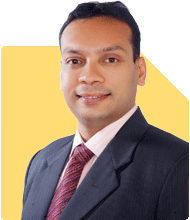Ramalingam Kalirajan |5367 Answers |Ask -Follow
Mutual Funds, Financial Planning Expert - Answered on May 14, 2024
He has an MBA in finance from the University of Madras and is a certified financial planner.
He is the director and chief financial planner at Holistic Investment, a Chennai-based firm that offers financial planning and wealth management advice.... more

Hii I am 35 years old, retiring in 2028 working in defence. I am holding corpus of 70 lakhs. 30L in PPF 30L in mutual fund stocks with SIP of 8k PM, I am holding 10L in fd. My requirements of future is 1cr for land purchase and 2 cr for future expenses. How to invest my corpus in effective ways.
Evaluating Your Current Portfolio
PPF (Public Provident Fund): Holding 30 lakhs in PPF provides stability and tax-free returns. However, since you're retiring in 2028, consider diversifying a portion of this amount into higher-return investments to meet your long-term goals.
Mutual Funds and Stocks: Your SIP in mutual funds and stocks is a sound strategy for wealth accumulation. Given your retirement timeline, maintain a balanced portfolio with a mix of equity and debt funds to mitigate risk while aiming for growth.
Fixed Deposits (FDs): While FDs offer security, the returns may not outpace inflation, potentially eroding purchasing power over time. Consider reallocating a portion of this amount into investments offering higher potential returns.
Investment Strategy for Future Goals
Land Purchase (1 crore): Since this is a short-to-medium-term goal, prioritize capital preservation and liquidity. Consider allocating a portion of your FD and PPF corpus towards a high-yield savings account or short-term debt funds to accumulate the required amount by 2028.
Future Expenses (2 crore): With a longer time horizon, you can afford to take on more risk for potential higher returns. Allocate a significant portion of your mutual fund and stock portfolio towards this goal, focusing on diversified equity funds to capitalize on market growth over the next few years.
Actionable Steps
Review Asset Allocation: Ensure your portfolio is well-diversified across asset classes (equity, debt, and cash) to manage risk and optimize returns.
Regular Monitoring: Periodically review your portfolio's performance and make adjustments as needed to stay on track towards your goals.
Consider Professional Advice: Consult with a Certified Financial Planner to tailor an investment strategy based on your risk tolerance, financial goals, and retirement timeline.
Your proactive approach to financial planning is commendable. By strategically allocating your existing corpus and adopting a disciplined investment strategy, you're setting yourself up for financial security in retirement. Stay focused, stay informed, and continue taking steps towards achieving your goals.
Best Regards,
K. Ramalingam, MBA, CFP,
Chief Financial Planner,
www.holisticinvestment.in
You may like to see similar questions and answers below
Ramalingam Kalirajan |5367 Answers |Ask -Follow
Mutual Funds, Financial Planning Expert - Answered on May 06, 2024
Ramalingam Kalirajan |5367 Answers |Ask -Follow
Mutual Funds, Financial Planning Expert - Answered on May 14, 2024
Ramalingam Kalirajan |5367 Answers |Ask -Follow
Mutual Funds, Financial Planning Expert - Answered on Jul 13, 2024
Ramalingam Kalirajan |5367 Answers |Ask -Follow
Mutual Funds, Financial Planning Expert - Answered on Jul 25, 2024
Dr Nagarajan J S K |58 Answers |Ask -Follow
Health Science and Pharmaceutical Careers Expert - Answered on Jul 27, 2024
Dr Nagarajan J S K |58 Answers |Ask -Follow
Health Science and Pharmaceutical Careers Expert - Answered on Jul 27, 2024
Dr Nagarajan J S K |58 Answers |Ask -Follow
Health Science and Pharmaceutical Careers Expert - Answered on Jul 26, 2024
Krishna Kumar |358 Answers |Ask -Follow
Workplace Expert - Answered on Jul 26, 2024
Krishna Kumar |358 Answers |Ask -Follow
Workplace Expert - Answered on Jul 26, 2024
Krishna Kumar |358 Answers |Ask -Follow
Workplace Expert - Answered on Jul 26, 2024
Krishna Kumar |358 Answers |Ask -Follow
Workplace Expert - Answered on Jul 26, 2024
Krishna Kumar |358 Answers |Ask -Follow
Workplace Expert - Answered on Jul 26, 2024
Krishna Kumar |358 Answers |Ask -Follow
Workplace Expert - Answered on Jul 26, 2024
Krishna Kumar |358 Answers |Ask -Follow
Workplace Expert - Answered on Jul 26, 2024




















